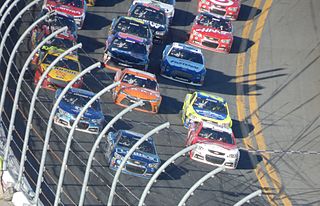
The Targa New Zealand is a tarmac rally held annually on public roads typically throughout the North Island of New Zealand. The main Targa each year begins in the last week of October and is a week-long event which covers around 1500 km of touring and 750 km of closed special stages. [1] Smaller one- or two-day events are usually run during the year and have been variously titled Targa Bambina, Targa Dash, Targa Rotorua, Targa Tauranga and Targa Hawkes Bay.

Rally is a form of motorsport that takes place on public or private roads with modified production or specially built road-legal cars. It is distinguished by running not on a circuit, but instead in a point-to-point format in which participants and their co-drivers drive between set control points, leaving at regular intervals from one or more start points. Rallies may be won by pure speed within the stages or alternatively by driving to a predetermined ideal journey time within the stages.

New Zealand is a sovereign island country in the southwestern Pacific Ocean. The country geographically comprises two main landmasses—the North Island, and the South Island —and around 600 smaller islands. New Zealand is situated some 2,000 kilometres (1,200 mi) east of Australia across the Tasman Sea and roughly 1,000 kilometres (600 mi) south of the Pacific island areas of New Caledonia, Fiji, and Tonga. Because of its remoteness, it was one of the last lands to be settled by humans. During its long period of isolation, New Zealand developed a distinct biodiversity of animal, fungal, and plant life. The country's varied topography and its sharp mountain peaks, such as the Southern Alps, owe much to the tectonic uplift of land and volcanic eruptions. New Zealand's capital city is Wellington, while its most populous city is Auckland.
Contents
In 2014 Targa New Zealand for the first time was held in the South Island of New Zealand. Starting in Christchurch and finishing in Cromwell (Near Queenstown) the rally included every South Island race track including New Zealand's latest - Highlands Motorsport Park. Noticeable stages included Queenstown's Crown Range which is understood to be one of New Zealand's highest altitude public roads.
Originally intended as an event for owners of classic performance cars to display and race their vehicles, it has evolved into a serious competition event with modern purpose built race cars usually taking top honours.
The race started in 1995 [1] and continually growing in popularity with over 200 cars entering the 2005 Dunlop sponsored Targa rally.
Racing is divided into classes to give everyone a chance of honours of some sort. These classes are based around age and engine size of the vehicles. Younger drivers are encouraged to compete in a controlled manner in a safe environment. Crashes happen but it is a very low percentage. Race cars need to have roll cages and safety gear except the Targa tour for first-time competitors. They drive under the guidance of the tour leader. Local groups providing hospitality areas, fundraising activities such as car washes, barbecues and 4000 lunches. [1]
Classes for Early Targa Events
- Historic
- Pre-classic
- Classic
- Post classic
- Metalman super classics
- Metalman all-comers
- Early modern
- Honda riders contemporary
- Super GT
Classes for Current Targa Events
Classic 2WD
- Category 1 0 – 2000cc Aftermarket sequential gearboxes are prohibited
- Category 2 2001 – 3400cc Aftermarket sequential gearboxes are prohibited
- Category 3 3401cc and over Aftermarket sequential gearboxes are prohibited
Production (GT2) 2WD
- Category 4 0 – 2000cc Aftermarket sequential gearboxes are prohibited
- Category 5 2001 – 3400cc Aftermarket sequential gearboxes are prohibited
- Category 6 3401cc and over Aftermarket sequential gearboxes are prohibited
Production (GT4) 4WD
- Category 8 Pre 2000 1st year of production prior to 1 January 2000. Aftermarket sequential gearboxes are prohibited
- Category 9 Post 2000 1st year of production after to 1 January 2000. Aftermarket sequential gearboxes are prohibited
Allcomers (Extreme) 2WD and 4WD
- Category 7 Open 2WD All 2 wheel drive vehicles not eligible for Categories 1–6.
- Category 10 Open 4WD All 4 wheel drive vehicles not eligible for Categories 8-9.



















